Welcome to the wild world of sun stress, succulent sunburn care, and watering strategies!
Let me paint you a picture: You have lovingly nurtured your succulent collection, positioning them just so, hoping they’ll soak up that glorious sunshine.
But wait – what’s happening? Those beautiful green leaves are turning an alarming red, brown, or white shade.
Welcome to the wild world of succulent sun stress and sunburn!
Spoiler alert: Not all sun stress is bad, but too much can turn your plant paradise into a botanical disaster zone.
Let’s dive into everything you need to know about keeping your succulents happy, healthy, and almost as extraordinary as you are.
Also Read: Succulent Plant Names
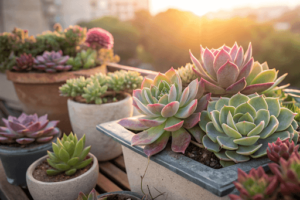
Sun Stress and Sunburn in Succulents
What is Sun Stress?
Sun stress, succulent sunburn care, and watering techniques are interconnected in maintaining your plants’ vibrant health
Sun stress is like a plant’s suntan – but with WAY more attitude.
When succulents receive intense sunlight, they can develop stunning color changes.
Some plant parents intentionally stress their succulents to bring out vibrant reds, purples, and pinks.
It’s the plant equivalent of a glow-up but with serious risks.
Pro Tip: Think of sun stress like a controlled workout for your plants.
Too little? Boring. Too much? Potential disaster.
The Science Behind Sun Stress
How Sun Stress Works:
- Succulents produce protective pigments called anthocyanins
- These pigments act as a natural sunscreen
- Color changes are a defensive mechanism against intense light
Types of Sun Stress Responses
1. Color Transformation
- Soft pinks
- Deep purples
- Vibrant reds
- Subtle oranges
2. Stress Indicators
- Compact growth
- Tighter leaf formation
- Enhanced pigmentation
- Reduced leaf size
Intentional Sun Stressing: A Controversial Art Form
Pros of Intentional Sun Stress:
- Creates visually stunning plants
- Mimics natural desert conditions
- Demonstrates advanced plant care skills
Cons of Intentional Sun Stress:
- Risk of permanent damage
- Requires precise environmental control
- Not suitable for all succulent varieties
Sun Stress vs. Sunburn: Knowing the Difference

Characteristic Sun Stress Sunburn
| Characteristic | Sun Stress | Sunburn |
|---|---|---|
| Color Change | Vibrant, intentional | Brown, damaged |
| Plant Health | Temporary adaptation | Potentially permanent damage |
| Duration | Short-term | Long-term effects |
| Plant Response | Protective pigment production | Cellular destruction |
Factors Influencing Sun Stress
Key Environmental Factors:
- Light Intensity
- Duration of Exposure
- Temperature
- Hydration Levels
- Succulent Species
Sun Stress Techniques for Different Succulent Types
Expert-Level Stress Strategies:
1. Echeveria
- Gradual light exposure
- 4-6 hours in direct sunlight
- Ideal for color transformation
2. Aeonium
- Morning sun preferred
- Protect from intense afternoon heat
- Subtle color changes
3. Sedum
- Most tolerant to direct sunlight
- Dramatic color shifts
- Requires careful monitoring
The Psychological Aspect of Sun Stress
Plant Parent’s Emotional Rollercoaster:
- Excitement of color changes
- Anxiety about potential damage
- Pride in successful stress management
Common Sun Stress Myths Debunked
- Myth: All succulents respond the same to sun stress. Reality: Each species has unique light tolerance
- Myth: More stress means better colors. Reality: Balanced, controlled stress yields the best results
Monitoring and Measuring Sun Stress
Stress Tracking Techniques:
- Take weekly photographs
- Note color changes
- Measure leaf compactness
- Track environmental conditions
When Sun Stress Goes Wrong
Warning Signs:
- Bleached, washed-out colors
- Crispy leaf edges
- Stunted growth
- Loss of plant vitality
Advanced Sun Stress Management
Pro Tips:
- Use shade cloths
- Create microclimates
- Rotate plants regularly
- Understand individual plant needs
Ethical Considerations
Responsible Plant Parenting:
- Prioritize plant health
- Avoid extreme stress
- Observe and adopt
- Respect each plant’s characteristics.
Sun stress is an intricate dance between plant survival and aesthetic beauty.
It requires patience, observation, and a deep understanding of your succulent’s unique personality.
Treat sun stress like a fine art – with respect, skill, and a touch of botanical intuition.

What is Succulent Sunburn?
Succulent sunburn is like a plant’s worst nightmare.
This painful, damaging condition occurs when plants receive too much direct, intense sunlight.
Unlike humans who can apply sunscreen, succulents are at the mercy of their environment.
Identifying Sunburn: The Warning Signs
Sunburn Stages in Succulents:
1. Early Stage Sunburn
- Pale or white patches on leaves
- Slightly translucent appearance
- Soft, discolored areas
2. Moderate Sunburn
- Brown or dark spots
- Crispy, dried-out leaf edges
- Unusual texture changes
3. Severe Sunburn
- Large brown or black patches
- Completely dried, brittle leaves
- Potential structural damage to the plant
Why Succulents Get Sunburned
Sunburn happens due to several factors:
- Sudden exposure to intense sunlight
- Transplanting from low-light to high-light environments
- Lack of gradual acclimatization
- Dehydration
- Weak or stressed plant conditions
Preventing Succulent Sunburn: A Survival Guide
Sunburn Prevention Strategies:
1. Gradual Exposure
- Introduce plants to direct sunlight slowly
- Start with 1-2 hours of morning sun
- Gradually increase exposure over weeks
2. Strategic Placement
- Use shade cloths
- Create temporary barriers
- Utilize natural shade from other plants or structures
3. Hydration is Key
- Keep plants well-hydrated before sun exposure
- Water deeply but infrequently
- Avoid midday watering in intense heat
Healing Sunburned Succulents: Rescue Mission
Step-by-Step Recovery Plan:
2. Immediate Relocation
- Move to partial shade
- Avoid direct afternoon sun
- Create a protective environment
3. Minimal Intervention
- Stop fertilizing
- Reduce watering
- Allow plants to recover naturally
4. Pruning Strategy
- Remove completely dead leaves
- Leave partially damaged leaves for plant protection
- Use clean, sterilized cutting tools
Pro Tips from Succulent Experts
Insider Knowledge:
- Some succulents can develop beautiful stress colors
- Not all color changes indicate damage
- Learn your specific plant’s light tolerance
Table: Succulent Sun Tolerance Levels
Succulent Type Sun Tolerance Ideal Conditions
| Succulent Type | Sun Tolerance | Ideal Conditions |
| Echeveria | Moderate | Morning sun, afternoon shade |
| Aloe Vera | High | Bright, indirect light |
| Sedum | Very High | Full sun to partial shade |
| Haworthia | Low | Indirect, filtered light |
Long-Term Care After Sunburn
Recovery Monitoring:
- Check for new growth
- Observe overall plant health
- Be patient during the recovery process
Common Myths Debunked
- Myth: All succulents love full sun. Reality: Each species has unique light requirements
- Myth: Sunburned leaves will recover. Reality: Damaged leaves won’t turn green again
When to Seek Professional Help
Red Flags:
- Extensive damage.
- No new growth after 4-6 weeks.
- Signs of rot or severe stress.
Preventing sunburn is about understanding, patience, and observation.
Treat your succulents like the delicate desert survivors they are – with respect, care, and a bit of plant parent intuition.
Remember: Every sunburn is a learning opportunity for you and your plant!

The Fine Line Between Stress and Sunburn
Stress Level Plant Reaction Recommended Action
| Stress Level | Plant Reaction | Recommended Action |
| Mild Stress | Color Changing | Monitor and Enjoy |
| Moderate Stress | Slight Discoloration | Provide Partial Shade |
| Severe Stress | Crispy, Brown Leaves | Immediate Intervention Needed |
Preventing Sunburn in Succulents
Succulents are sun-loving plants, but even the hardiest species need careful handling to avoid sunburn.
Prevention is always easier than repair, so implementing these strategies can help protect your plants from irreversible damage.
Gradual Acclimation
Introducing succulents to direct sunlight should be gradual, mainly if kept indoors or in shaded environments.
Here’s a step-by-step guide to ease them into brighter conditions:
- Start Small: Begin with 30 minutes of direct sunlight exposure daily.
- Increase Incrementally: Add an extra hour of sun exposure every 2–3 days, monitoring for any signs of stress or color change.
- Adjust Based on Plant Response: If you notice signs of sun stress, such as leaf discoloration, reduce exposure time or provide shade immediately.
- Complete Acclimation: After a few weeks of this gradual process, many succulents can handle several hours of direct sunlight daily without stress.
Providing Shade
Even for sun-acclimated succulents, certain conditions like heat waves or peak afternoon sun can be too harsh.
Providing shade during these times can prevent sunburn.
- Use Shade Cloths: Lightweight, breathable fabric can block harmful UV rays while allowing adequate light.
- Repurpose Household Items: Old bedsheets or umbrellas can be temporary shade solutions during unexpected heat spikes.
- Strategic Placement: Arrange potted succulents near taller plants, walls, or east-facing areas to provide natural shade during the hottest parts of the day.
Understanding Plant Needs
Not all succulents are created equal when it comes to sun tolerance.
Knowing the needs of your specific plants can prevent damage before it starts.
Categorizing Tolerance:
- Sun-Tolerant Varieties: Echeverias, sedums, and agaves thrive in direct sunlight, especially after proper acclimation.
- Shade-Loving Varieties: Haworthias and gasterias prefer indirect light and are prone to sunburn under harsh conditions.
Visual Cues for Stress:
- Succulents with farina (a powdery coating) or brightly colored leaves often tolerate sunlight better.
- Green, fleshy succulents are more prone to stress and sunburn and require extra care.
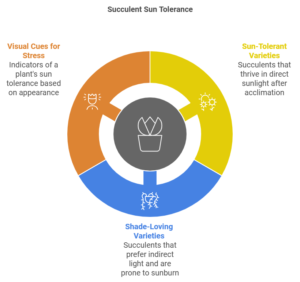
Caring for Sunburned Succulents
Once a succulent shows signs of sunburn, immediate action is essential to prevent further damage and support recovery.
For a detailed guide on summer care and sunburn remedies for succulents, check out Debra Lee Baldwin’s comprehensive guide.
Immediate Actions
The first step in treating a sunburned succulent is to move it to a shadier spot.
An area with bright but indirect light allows the plant to recover without additional stress.
For potted plants, relocating is straightforward; for garden succulents, consider temporary shading solutions.
Watering Adjustments
Proper hydration is crucial for recovery, but overwatering can worsen the plant’s stress.
- Water Thoroughly: Ensure the soil is evenly moist but not soggy. Water only when the soil is completely dry.
- Frequency Adjustments: Increase watering frequency slightly during recovery periods, especially in hot weather, while avoiding standing water.
Reducing Fertilizer Use
Nutrients can overwhelm a stressed succulent, as its energy is already focused on repair.
- Hold off on fertilizing until the plant shows signs of new growth.
- Resume fertilizing with a diluted solution once the plant has fully recovered.
Leaf Management
Damaged leaves detract from a succulent’s appearance and can drain its resources.
- Trim Severely Burnt Leaves: Use sterilized scissors to remove entirely damaged leaves, ensuring they do not cut into healthy tissue.
- Leave Mildly Affected Leaves: They can still contribute to photosynthesis and provide nutrients as the plant recovers.
Patience and Monitoring
Recovery from sunburn can take weeks or even months.
Regularly check for signs of improvement, such as new leaf growth or a return to regular coloring.
To avoid further setbacks, maintain consistent care, including proper watering and light exposure.
Your succulents can thrive even under challenging conditions by combining preventive measures with thoughtful recovery practices.
Best Practices for Watering Sun-Stressed or Sunburned Succulents
Watering is critical to succulent care, especially when plants are stressed by excessive sunlight or recovering from sunburn.
Applying the proper techniques can prevent further damage and encourage healthy growth.
Increased Frequency During Heat
High temperatures, significantly above 90°F (32°C), increase the evaporation rate, leaving succulents prone to dehydration. Adjusting watering frequency during heatwaves is essential.
Observe the Soil: Check if the soil dries out faster than usual and water accordingly.
During extreme heat, you may need to water every other day for potted plants.
Deep, Thorough Watering: Ensure water penetrates deeply into the soil to reach the root zone.
Shallow watering can leave roots dehydrated and susceptible to stress.
Evening Check-Ins: Monitor your plants at the end of the day for signs of heat stress, such as droopy or wrinkled leaves, and adjust care as needed.
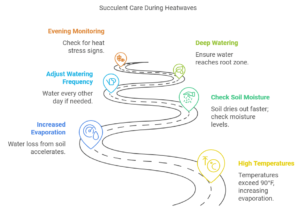
Timing Matters
Regarding watering, the timing can make all the difference in helping succulents thrive under intense sunlight.
Morning Advantage: Watering in the early morning allows the soil to absorb moisture before the day’s heat peaks, helping keep roots cool and hydrated.
Avoid Midday Watering: The combination of water and intense sunlight can cause leaf burns, as water droplets act like magnifying glasses.
Consistency Is Key: Stick to a watering schedule based on environmental conditions to avoid overwatering or neglect.
Avoiding Water on Leaves
Sunburned or stressed succulents have sensitive leaves, and water droplets on their surface can amplify sunlight exposure, causing further damage.
Base Watering Techniques: Use a watering can or hose with a narrow spout to direct water at the base of the plant, avoiding the leaves entirely.
Drip Irrigation for Gardens: Set up drip systems to ensure precise watering without splashing the leaves.
Potted Plant Tip: Elevate pots slightly or use saucers with drainage holes to avoid water pooling around the base.
Additional Tips for Thriving Succulents in Sun and Heat
Caring for succulents in sunny, hot climates involves more than just watering.
Strategic placement, species-specific care, and environmental adjustments can ensure they thrive despite the challenging conditions.
Optimal Placement
Where you place your succulents can significantly affect their ability to handle sunlight and heat.
East-Facing Spots: Ideal for providing gentle morning sun while protecting plants from the harsh afternoon rays.
Rotational Exposure: For potted plants, rotate their position every few weeks to ensure light distribution and prevent one side from receiving excessive exposure.
Microclimates: Take advantage of naturally cooler, shaded areas near walls, trees, or other structures that can shield succulents during the hottest times of the day.
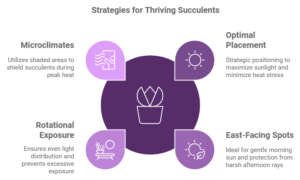
Species-Specific Care
Different succulents have unique needs, and tailoring care to individual species is critical for their success.
Research Before Placement: Identify whether your succulent prefers full sun (e.g., echeverias, sedums) or partial shade (e.g., haworthias, gasterias).
Monitor Signs of Stress: Each species reacts differently to sun exposure.
Watch for signs like color changes or drooping leaves and adjust care accordingly.
Temperature Tolerance: Some varieties, like cacti, thrive in high heat, while others may require extra shade or cooling techniques.
Using Mulch
Mulching is a simple yet effective way to regulate soil temperature and retain moisture, especially for garden succulents.
Choose the Right Mulch: Opt for gravel, pebbles, or bark that complement succulents’ aesthetic and drainage needs.
Application Tips: Spread a thin layer of mulch around the base of the plant, avoiding direct contact with the stems to prevent rot.
Benefits: Mulch keeps the soil cooler during the day and reduces water evaporation, making it an excellent addition to outdoor succulents.
Temporary Shade Solutions
Sometimes, even the most sun-tolerant succulents need a break during extreme heatwaves.
Providing temporary shade can make a significant difference.
Quick Fixes: Use items like umbrellas, cardboard, or bedsheets to create makeshift shade for outdoor succulents during peak sun hours.
Portable Protection: Move potted plants to sheltered areas, such as patios or shaded balconies, during heatwaves.
Long-Term Solutions: Consider investing in adjustable shade cloths or pergolas to shield plants during prolonged hot seasons.
Incorporating these watering and care practices into your routine can help your succulents survive and flourish under sunny and hot conditions.
Thoughtful adjustments tailored to your plant’s needs can ensure its long-term health and vibrancy.
Conclusion
Caring for succulents under intense sunlight and extreme heat can be challenging.
Still, with the proper prevention and care strategies, you can ensure your plants thrive.
By understanding the signs of sun stress and sunburn and taking proactive steps to protect and heal your succulents, you’ll set them up for long-term success.
FAQs:
Q: Will Sunburnt Leaves Turn Green Again?
Short answer: No. Those leaves are like overcooked toast – permanently damaged.
Q: Should I Remove Sunburned Leaves?
Remove only completely dead or rotting leaves. Partial damage? Let them be – they’re still protecting the plant.
Q: Can Plants Recover from Heat Burn?
Absolutely! Most succulents are more resilient than a teenage drama queen with proper care.
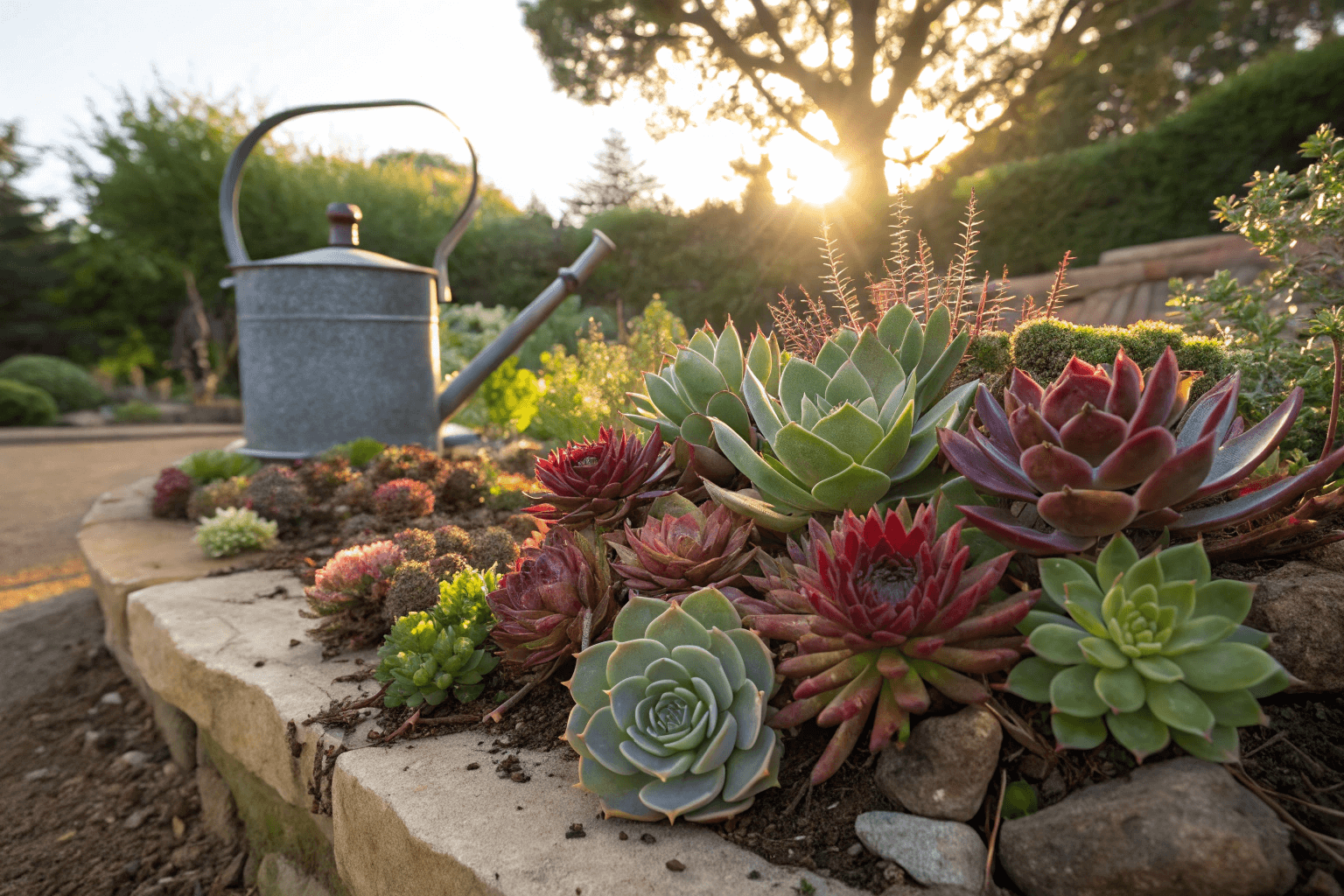








5 Responses